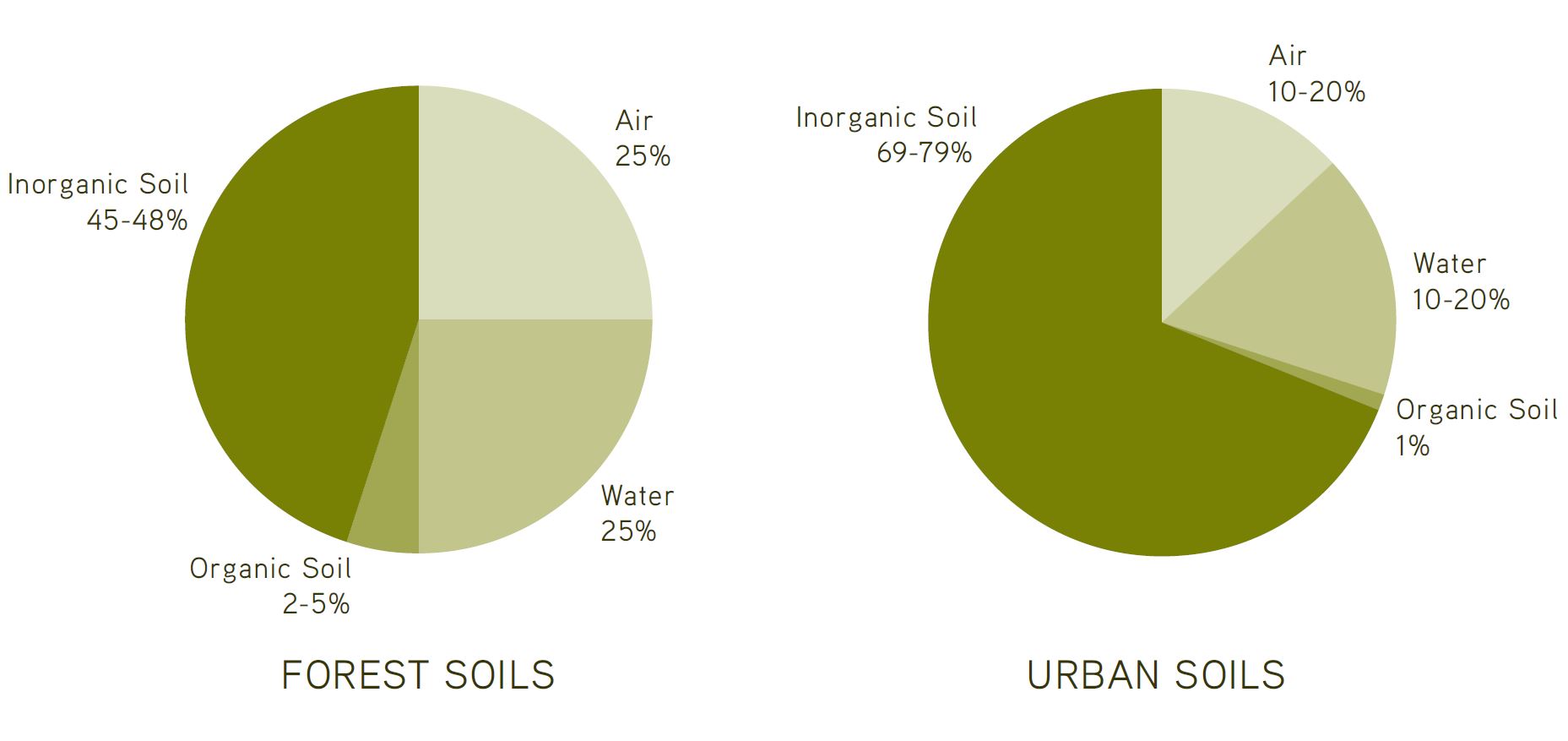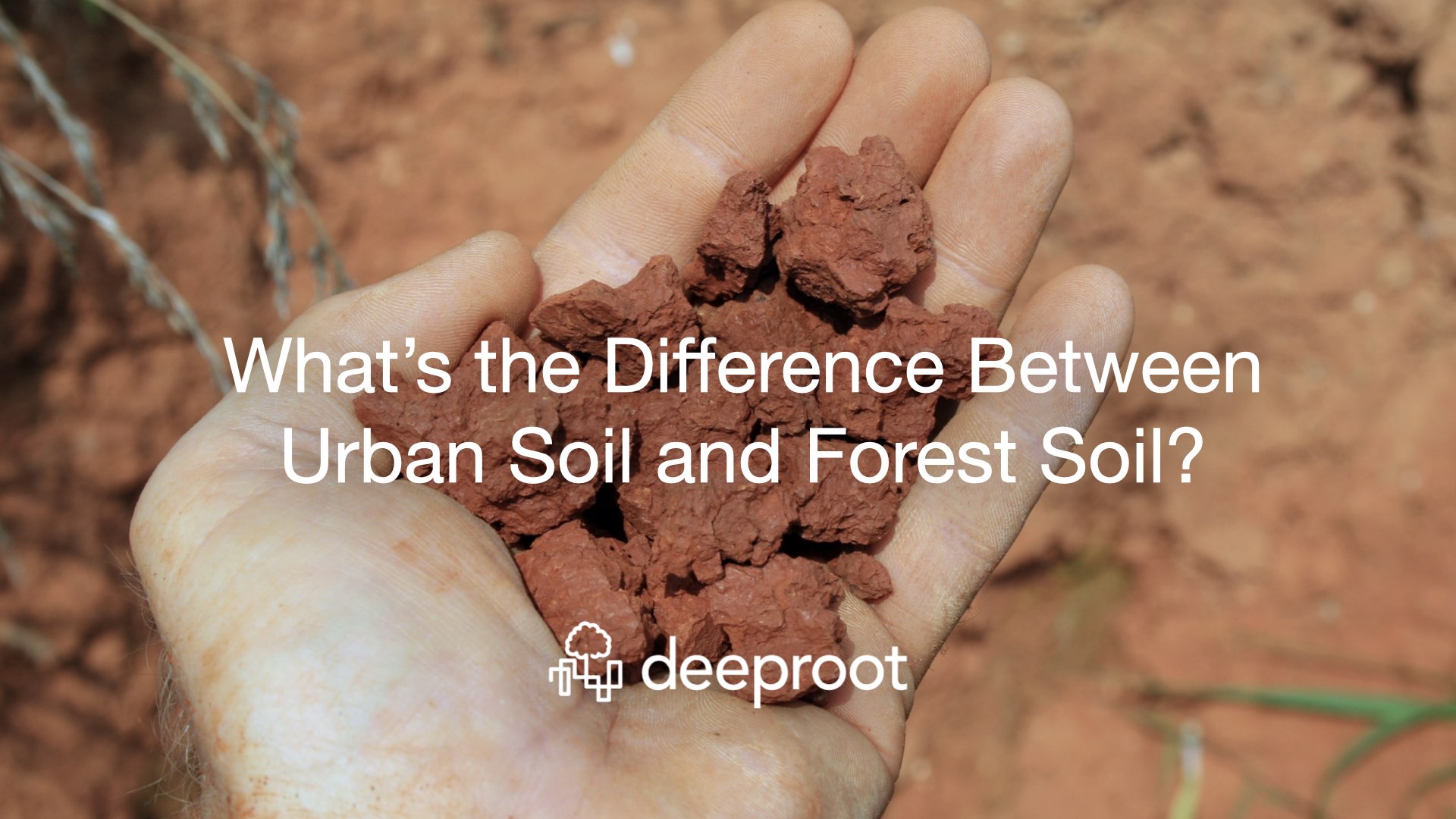You don’t need much experience in arboriculture or landscape design to notice that planting trees in cities is very different from planting trees in forest environments. There are many reasons for this, but perhaps the biggest is the difference in composition of the soil.
What do we mean when we say that urban soils are inhospitable for trees? Soil has six basic properties that are important to plant growth: structure, texture, pH, density, organic matter and nutrients. These all influence its fertility as a growing medium, and are subject to degradation and complications in urban areas.
Structure
Structure refers to the shape, size, strength and arrangement of soil particles in to aggregates (also called peds or crumb). Structure is formed by activity of soil organisms, root growth, freeze/thaw cycles, and more. A soil’s structure is what creates macropores (where water is held) and micropores (where air is held), both of which are essential for root growth.
In order to build load-bearing structures like buildings and roads, soil needs to be heavily compacted. This breaks down the structure of the soil, filling the pore space with soil particles and eliminating space for air and water. Without air space to penetrate and allow for gas exchange, and without water to carry and transport nutrients, roots will not be able to grow and nourish the tree. While there may technically be soil underneath most sidewalks, if it is heavily compacted it becomes functionally useless from the tree’s perspective.
Texture
Soil texture describes its relative fineness or coarseness, specifically in terms of sand, silt and clay. This composition determines much about a soil — for example, how well it holds water, its Cation Exchange Capacity (CEC) level and its buffering capacity. Texture is an important characteristic to be aware of when selecting plantings; not all trees thrive equally in all soils.
Although natural (native) soils are often good-quality, they are not uniformly superior to manufactured or amended soils for plant growth. Some are very difficult growing media. It’s important to thoughtfully match the plant with the soil conditions to increase their chances for success.
pH
pH is the measure of the acidity or alkalinity of soil. The entire pH range goes from zero to 14, but only a small section of that — 6 to 6.5 or so — is favorable for most trees. Soil pH influences which organisms are present in the soil food web and also the availability of mineral elements (which are absorbed through water) for the tree. Trees will struggle in soils that are either too alkaline or too acidic.
“Managed” soils tend to decline in pH. Liming agents can correct this deficiency in the short term, but it’s extremely difficult to make long-term adjustments to the pH level.
Density
Naturally-formed soils tend to achieve compaction (bulk density) rates that are stable while still being supportive of plant growth.
Urban soils, as mentioned above, are often heavily compacted in order to meet safety and engineering standards for buildings and roads. Soil with high bulk density usually does not have sufficient macropore or micropore space to allow for air and water circulation that is critical for root growth. The reason the Silva Cell is such a valuable tool is that it can support loading requirements while creating a void space to be filled with lightly compacted planting soil.
Organic Matter
Organic matter is an important component of healthy soils, as it is the basis of life in the soil food web. To be clear, trees do not “consume” organic matter. In forest settings, organic matter is replenished through decaying duff and organisms. In urban environments, trees are capable of replenishing soil organic matter themselves (more on that in another post). Overall, soil organic matter occupies a smaller percentage of the total volume than many people assume.

Nutrients
Trees make their own food through photosynthesis, but they still require nutrients for their overall health. Macronutrients (Nitrogen, Phosphorous and Potassium are the ones you’ll hear about the most) are required in large amounts and micronutrients are required in smaller amounts. Nutrient availability will depend on many factors, and fertilization, if necessary, should be done when soil or foliar testing indicates that there is a deficiency.
Plants cannot absorb nutrients without adequate hydration, so sites that have poor drainage — a common problem with heavily compacted soils and areas where this is a lot of paving — can limit nutrient uptake and create difficult growing conditions.
Conclusion
In addition to affecting these basic soil qualities listed here, urban environments introduce other factors as well, such as anthropogenic materials, pollutants, and more. Urban soils also tend to have less organic matter, which is the basis of the life for the soil food web and an important factor in the creation of soil structure.
Understanding soil characteristics is just a starting point in understanding how and why urban soils are different from forest soils, as well as the effect on tree health and survival. The movement of water around and through the site, which I only touch on here tangentially, is an example of another extremely important site factor that is altered, and often disrupted, in urban areas.
Retaining pre-development soil quality (like maintaining pre-development site hydrology) is an ongoing challenge in the built environment, where construction and development are ongoing. However, with thoughtful planning and effort throughout the design and construction process, soil disturbance can be minimized. Naturally-formed soils are a far more valuable resource than most people recognize, and preserving them should be a priority.
This blog post was originally published in 2014.






Under the blog section: Structure: “A soil’s structure is what creates macropores (where water is held) and micropores (where air is held)”
I think that the author should consider refining this statement as it is misleading of the function of these pore types in a soil. RE: Macro, meso and micro. Drainage, retention and hygroscopic. Or perhaps as a relationship to growing plants: gravitational water, plant available water and unavailable water. Just my thoughts.